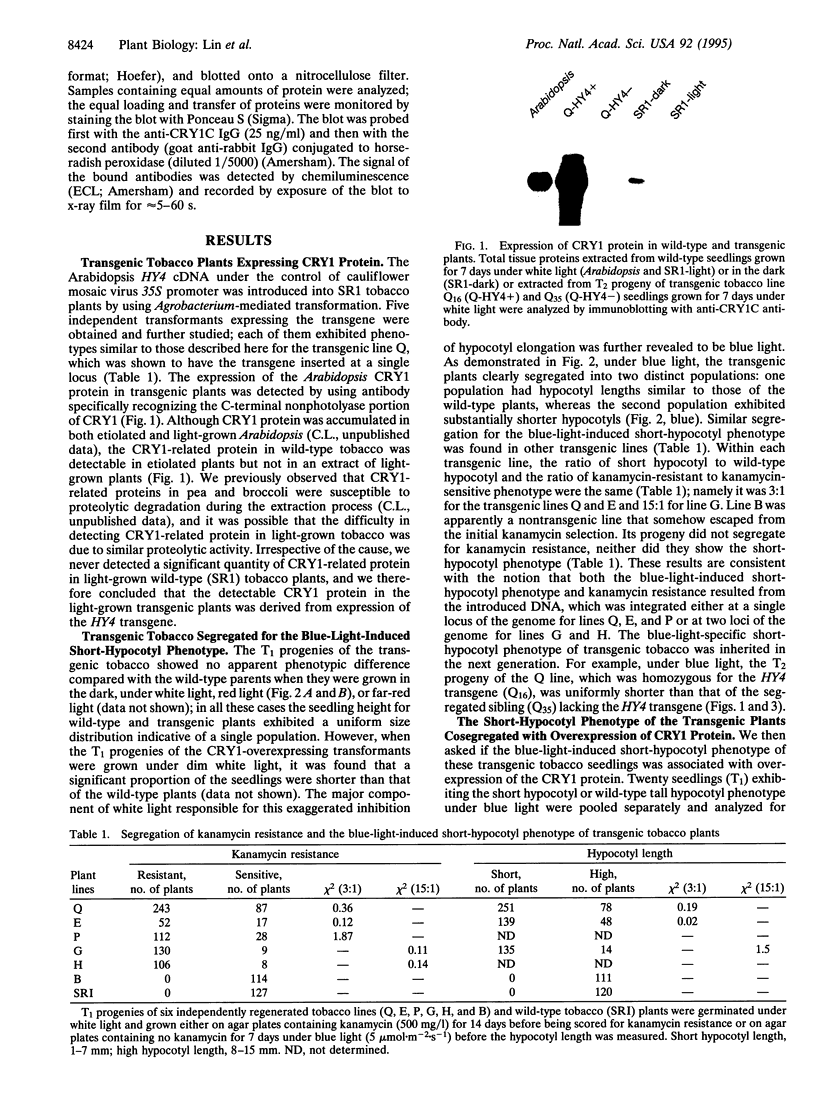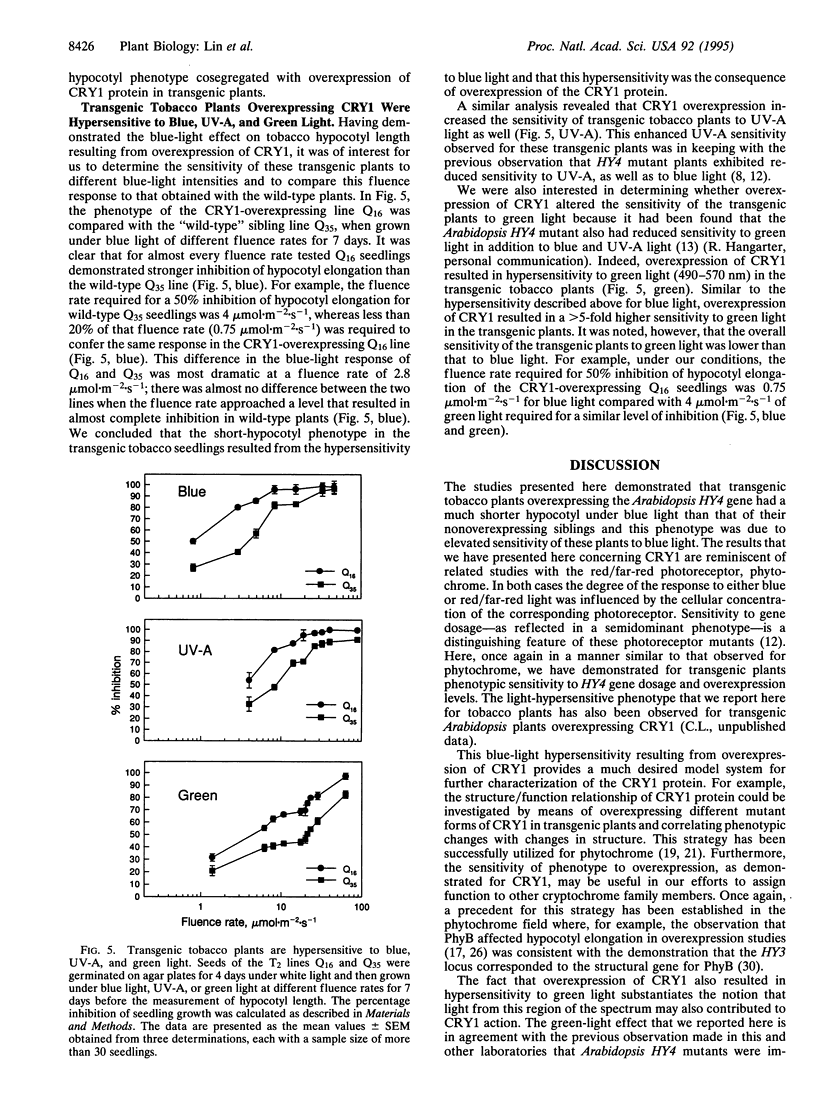Abstract
The Arabidopsis HY4 gene, required for blue-light-induced inhibition of hypocotyl elongation, encodes a 75-kDa flavoprotein (CRY1) with characteristics of a blue-light photoreceptor. To investigate the mechanism by which this photoreceptor mediates blue-light responses in vivo, we have expressed the Arabidopsis HY4 gene in transgenic tobacco. The transgenic plants exhibited a short-hypocotyl phenotype under blue, UV-A, and green light, whereas they showed no difference from the wild-type plant under red/far-red light or in the dark. This phenotype was found to cosegregate with overexpression of the HY4 transgene and to be fluence dependent. We concluded that the short-hypocotyl phenotype of transgenic tobacco plants was due to hypersensitivity to blue, UV-A, and green light, resulting from over-expression of the photoreceptor. These observations are consistent with the broad action spectrum for responses mediated by this cryptochrome in Arabidopsis and indicate that the machinery for signal, transduction required by the CRY1 protein is conserved among different plant species. Furthermore, the level of these photoresponses is seen to be determined by the cellular concentration of this photoreceptor.
Full text
PDF




Images in this article
Selected References
These references are in PubMed. This may not be the complete list of references from this article.
- Ahmad M., Cashmore A. R. HY4 gene of A. thaliana encodes a protein with characteristics of a blue-light photoreceptor. Nature. 1993 Nov 11;366(6451):162–166. doi: 10.1038/366162a0. [DOI] [PubMed] [Google Scholar]
- Boylan M. T., Quail P. H. Oat Phytochrome Is Biologically Active in Transgenic Tomatoes. Plant Cell. 1989 Aug;1(8):765–773. doi: 10.1105/tpc.1.8.765. [DOI] [PMC free article] [PubMed] [Google Scholar]
- Boylan M. T., Quail P. H. Phytochrome a overexpression inhibits hypocotyl elongation in transgenic Arabidopsis. Proc Natl Acad Sci U S A. 1991 Dec 1;88(23):10806–10810. doi: 10.1073/pnas.88.23.10806. [DOI] [PMC free article] [PubMed] [Google Scholar]
- Boylan M., Douglas N., Quail P. H. Dominant negative suppression of arabidopsis photoresponses by mutant phytochrome A sequences identifies spatially discrete regulatory domains in the photoreceptor. Plant Cell. 1994 Mar;6(3):449–460. doi: 10.1105/tpc.6.3.449. [DOI] [PMC free article] [PubMed] [Google Scholar]
- Cherry J. R., Hondred D., Walker J. M., Keller J. M., Hershey H. P., Vierstra R. D. Carboxy-terminal deletion analysis of oat phytochrome A reveals the presence of separate domains required for structure and biological activity. Plant Cell. 1993 May;5(5):565–575. doi: 10.1105/tpc.5.5.565. [DOI] [PMC free article] [PubMed] [Google Scholar]
- Chory J., Peto C. A., Ashbaugh M., Saganich R., Pratt L., Ausubel F. Different Roles for Phytochrome in Etiolated and Green Plants Deduced from Characterization of Arabidopsis thaliana Mutants. Plant Cell. 1989 Sep;1(9):867–880. doi: 10.1105/tpc.1.9.867. [DOI] [PMC free article] [PubMed] [Google Scholar]
- Kaufman L. S. Transduction of Blue-Light Signals. Plant Physiol. 1993 Jun;102(2):333–337. doi: 10.1104/pp.102.2.333. [DOI] [PMC free article] [PubMed] [Google Scholar]
- Kay S. A., Nagatani A., Keith B., Deak M., Furuya M., Chua N. H. Rice Phytochrome Is Biologically Active in Transgenic Tobacco. Plant Cell. 1989 Aug;1(8):775–782. doi: 10.1105/tpc.1.8.775. [DOI] [PMC free article] [PubMed] [Google Scholar]
- Keller J. M., Shanklin J., Vierstra R. D., Hershey H. P. Expression of a functional monocotyledonous phytochrome in transgenic tobacco. EMBO J. 1989 Apr;8(4):1005–1012. doi: 10.1002/j.1460-2075.1989.tb03467.x. [DOI] [PMC free article] [PubMed] [Google Scholar]
- Laemmli U. K. Cleavage of structural proteins during the assembly of the head of bacteriophage T4. Nature. 1970 Aug 15;227(5259):680–685. doi: 10.1038/227680a0. [DOI] [PubMed] [Google Scholar]
- Nagatani A., Kay S. A., Deak M., Chua N. H., Furuya M. Rice type I phytochrome regulates hypocotyl elongation in transgenic tobacco seedlings. Proc Natl Acad Sci U S A. 1991 Jun 15;88(12):5207–5211. doi: 10.1073/pnas.88.12.5207. [DOI] [PMC free article] [PubMed] [Google Scholar]
- Ninnemann H. Some aspects of blue light research during the last decade. Photochem Photobiol. 1995 Jan;61(1):22–31. doi: 10.1111/j.1751-1097.1995.tb09239.x. [DOI] [PubMed] [Google Scholar]
- Parks B. M., Quail P. H. hy8, a new class of arabidopsis long hypocotyl mutants deficient in functional phytochrome A. Plant Cell. 1993 Jan;5(1):39–48. doi: 10.1105/tpc.5.1.39. [DOI] [PMC free article] [PubMed] [Google Scholar]
- Schardl C. L., Byrd A. D., Benzion G., Altschuler M. A., Hildebrand D. F., Hunt A. G. Design and construction of a versatile system for the expression of foreign genes in plants. Gene. 1987;61(1):1–11. doi: 10.1016/0378-1119(87)90359-3. [DOI] [PubMed] [Google Scholar]
- Somers D. E., Sharrock R. A., Tepperman J. M., Quail P. H. The hy3 Long Hypocotyl Mutant of Arabidopsis Is Deficient in Phytochrome B. Plant Cell. 1991 Dec;3(12):1263–1274. doi: 10.1105/tpc.3.12.1263. [DOI] [PMC free article] [PubMed] [Google Scholar]
- Wagner D., Tepperman J. M., Quail P. H. Overexpression of Phytochrome B Induces a Short Hypocotyl Phenotype in Transgenic Arabidopsis. Plant Cell. 1991 Dec;3(12):1275–1288. doi: 10.1105/tpc.3.12.1275. [DOI] [PMC free article] [PubMed] [Google Scholar]
- Wester L., Somers D. E., Clack T., Sharrock R. A. Transgenic complementation of the hy3 phytochrome B mutation and response to PHYB gene copy number in Arabidopsis. Plant J. 1994 Feb;5(2):261–272. doi: 10.1046/j.1365-313x.1994.05020261.x. [DOI] [PubMed] [Google Scholar]





